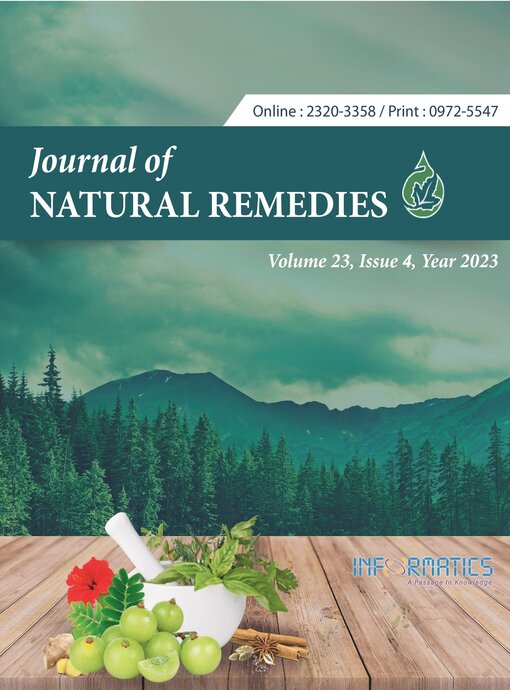Effect of Trivrit Virechana, Yashtyadi Pratisarana and Panchaksheeri Vriksha Kashaya Gandoosha in Periodontitis — A Case Series
DOI:
https://doi.org/10.18311/jnr/2023/31082Keywords:
Panchaksheerivriksha Kashaya, Periodontal Pathogen, Periodontitis, PratisaranaAbstract
Periodontitis is a localized inflammation of the teeth most commonly caused by a bacterial infection in the periodontal cavity. The disease is common in adults over the age of 30. The bacteria involved in periodontal disease are mainly Gram-negative anaerobes. According to Ayurveda, the specific symptoms of upakusha have similarities with periodontitis. The objective of this study was to evaluate the combined effect of virechana, pratisarana and gandusha in improving symptoms, gingival bleeding index, plaque index, and restoring normal salivary microbial profiles in patients with periodontitis. A group of 30 patients who met the inclusion criteria were recruited for the study. Each case was observed for prevalence by age, pain, gingival bleeding, halitosis, plaque index, gingival bleeding index. In the results, it was found that Trivrit virechana, Yashtyadi choorna prathisarana and Panchaksheerivriksha kashya gandusha showed significant reduction in pain, bleeding gums, halitosis, plaque index, bleeding gums and normalization of saliva pH and recovered the bacterial profile in saliva with an improvement of 100%, 100%, 98%, 100% and 100% respectively and was statistically significant with p<0.0001. So, Trivrit virechana purifies the koshta in turn keeps the oral cavity healthy and strengthen the periodontium. Yashtyadi choorna havs anti-inflammatory, antibacterial property inhibits the growth of periodontopathogen and Panchaksheerivriksha kashaya helps to normalize the pH of saliva and reduce the microbial load. Hence, Ayurveda management can be considered as a better alternative in the management of periodontitis.
Downloads
Metrics
Downloads
Published
How to Cite
Issue
Section
License
Copyright (c) 2022 NAYANA GANGADHARAN, Sivabalaji K, Ashwini B N

This work is licensed under a Creative Commons Attribution 4.0 International License.
Accepted 2023-09-04
Published 2023-11-08
References
Tariq M, Iqbal Z, Ali J, Baboota S, Talegaonkar S, Ahmad Z, Sahni JK. Treatment modalities and evaluation models for periodontitis. nternational Journal of Pharmaceutical Investigation. 2012; 2(3):106-22. https://doi.org/10.4103/2230-973X.104394 DOI: https://doi.org/10.4103/2230-973X.104394
Shaju JP, Zade RM, Das M. Prevalence of periodontitis in the Indian population: A literature review. Journal of Indian Society of Periodontology. 2011; 15(1):29. https://doi.org/10.4103/0972-124X.82261 DOI: https://doi.org/10.4103/0972-124X.82261
Lovegrove JM. Dental plaque revisited: bacteria associated with periodontal disease. New Zealand Society of Periodontology. 2004; (87):7-21.
Murthy KRS. Vagbhata Astanga Hridayam utharasthana, 6th edition, Chowkhambha Krishnadas Academy, Varanasi, Mukharoga Pratishedha; 2012.
Peiris KP, Rajagopala M, Patel N. A comparative study of Dashana Samskara Choorna Pratisarana and Dashana Samskara paste application in the management of Sheetada (Gingivitis). Ayu. 2013; 34(1):63-9. https://doi.org/10.4103/0974-8520.115452 DOI: https://doi.org/10.4103/0974-8520.115452
Mali GV, Dodamani AS, Karibasappa GN, Vishwakarma P, Jain VM. Comparative evaluation of Arimedadi oil with 0.2% chlorhexidine gluconate in prevention of plaque and gingivitis: A randomized clinical trial. Journal of Clinical and Diagnostic Research. 2016; 10(7): ZC31-4. https://doi.org/10.7860/JCDR/2016/19120.8132 DOI: https://doi.org/10.7860/JCDR/2016/19120.8132
Löe H. The gingival index, the plaque index and the retention index systems. Journal of Periodontology. 1967; 38(6): Suppl:610-6. https://doi.org/10.1902/jop.1967.38.6.610 DOI: https://doi.org/10.1902/jop.1967.38.6.610
Baliga S, Muglikar S, Kale R. Salivary pH: A diagnostic biomarker. Journal of Indian Society of Periodontology. 2013; 17(4):461-5. https://doi.org/10.4103/0972-124X.118317 DOI: https://doi.org/10.4103/0972-124X.118317
Aryal S. Gram staining: Principle, procedure, interpretation, examples and animation. Available from: https://microbiologyinfo.com/gram-staining-principle-procedure-interpretation-examples-and-animation/
Murthy KRS. Sushruta samhita, Chikitsa stana, Varanasi: Chaukhambha orientalia; 2012.
Murthy KRS. Vagbhata, Varanasi: Krishnadas Ayurveda series; vol-27. Astanga Hrdayam vol-3; p.203
Balasooriya BP, Peiris KP. Clinical effectiveness of Sphatikadi Prathisarana in the management of Sheetada (Gingivitis). Journal of Ayurvedic and Herbal Medicine. 2021; 7(1):19-23. https://doi.org/10.31254/jahm.2021.7105 DOI: https://doi.org/10.31254/jahm.2021.7105
Madan S, Kashyap S, Mathur G. Glycyrrhiza glabra: An efficient medicinal plant for control of periodontitis–A randomized clinical trial. Journal of the International Clinical Dental Research Organization. 2019; 11(1):32. https://doi.org/10.4103/jicdro.jicdro_7_19 DOI: https://doi.org/10.4103/jicdro.jicdro_7_19
Safii SH, Tompkins GR, Duncan WJ. Periodontal application of manuka honey: Antimicrobial and demineralising effects in vitro. International Journal of Dentistry. 2017; 2017. https://doi.org/10.1155/2017/9874535 DOI: https://doi.org/10.1155/2017/9874535
Bora GK, Vyas K. A clinical study on Triphala Kwatha Gandusha to prevent Dantamulagata Roga wsr to periodontal diseases as oral manifestations in Madhumeha (Diabetes mellitus). Journal of Ayurveda. p. 5-17
Murthy KRS. Bhavamisra, Bhavaprakasha, Vol 1, Varanasi: Chowkhamba krihnadas academy; 2001. p. 15-18, 295.
Takahashl N, SaitoK, Schachtele CF, Yamada T. Acid tolerance and acid‐neutralizing activity of Porphyromonas gingivalis, Prevotella intermedia and Fusobacterium nucleatum. Oral Microbiology and Immunology. 1997; 12(6):323-8. https://doi.org/10.1111/j.1399-302X.1997.tb00733.x DOI: https://doi.org/10.1111/j.1399-302X.1997.tb00733.x
Kishanrao KD, Veena KG. A brief review of research studies conducted on Panchavalkal. Indian Journal of Ancient Medicine and Yoga. 2015; 8(2):87. https://doi.org/10.21088/ijamy.0974.6986.8215.6 DOI: https://doi.org/10.21088/ijamy.0974.6986.8215.6
Sharma MK, Chaturvedi SK. A clinical evaluation of Panchavalkala—A review. Unique Journal of Ayurvedic and Herbal Medicine. 2014; 2:6-9.

 Nayana Gangadharan
Nayana Gangadharan









 0.35
0.35 24
24 0.161
0.161